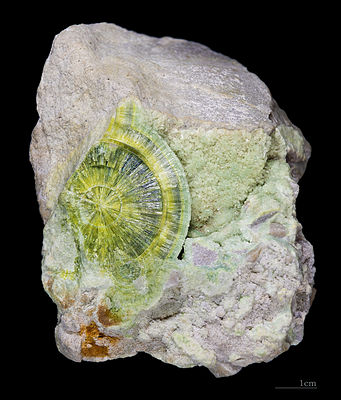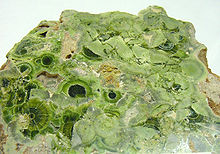Wavellite
| Wavellite | |
|---|---|
| Wavellite crystal specimen from Avant , Garland County, Arkansas , United States. | |
| General and classification | |
| chemical formula | Al 3 [(OH, F) 3 | (PO 4 ) 2 ] • 5H 2 O |
|
Mineral class (and possibly department) |
Phosphates, arsenates, vanadates |
|
System no. to Strunz and to Dana |
8.DC.50 ( 8th edition : VII / D.13) 42.10.02.01 |
| Crystallographic Data | |
| Crystal system | orthorhombic |
| Crystal class ; symbol | orthorhombic-dipyramidal; 2 / m 2 / m 2 / m |
| Room group (no.) | Pcmn (No. 62) |
| Lattice parameters | a = 9.621 Å ; b = 17.3630 Å; c = 6.994 Å |
| Formula units | Z = 6 |
| Physical Properties | |
| Mohs hardness | 3.5 to 4 |
| Density (g / cm 3 ) | 2.3 to 2.4 |
| Cleavage | completely after {110}; good after {101}; clearly after {010} |
| Break ; Tenacity | uneven |
| colour | colorless, white, yellowish, greenish |
| Line color | White |
| transparency | transparent to translucent |
| shine | Glass gloss, pearlescent gloss |
| Crystal optics | |
| Refractive indices |
n α = 1.518 to 1.535 n β = 1.524 to 1.543 n γ = 1.544 to 1.561 |
| Birefringence | δ = 0.026 |
| Optical character | biaxial positive |
| Axis angle | 2V = 60 to 72 ° |
Wavellite , synonymous as Fischerit and Lasionit known is a rarely occurring mineral from the mineral class of " phosphates , arsenates and vanadates ". It crystallizes in the orthorhombic crystal system with the chemical composition Al 3 [(OH, F) 3 | (PO 4 ) 2 ] · 5H 2 O and develops predominantly hemispherical to spherical, grape-like and radial mineral aggregates up to four centimeters in diameter, but also crusty coatings and rarely also prismatic, isometric to elongated crystals .
Special properties
Pure wavellite is colorless or white. However, it can be yellowish or greenish to bluish in color due to foreign admixtures, with the greenish colorations predominating. Zonal colorations similar to some of the tourmaline group minerals are also possible.
Wavellite is before the blowtorch infusible and soluble in hydrochloric acid .
Etymology and history
Wavellite was first found in 1805 by the British physicist William Wavell († 1829) and described by William Babington , who named the mineral after its discoverer.
At the beginning of the 19th century, a new variety of wavellite was found near Nizhne Tagilsk in the Urals , which was initially thought to be an independent mineral and named after Gotthelf Fischer von Waldheim (1771-1853) as fischerite . According to the only description by R. Hermann, the fischerite consisted of transparent, crystalline bark and short, prismatic crystals of grass-green to olive-green and chip-green color, which were found on fissures of sandstone and clay iron. However, later analyzes showed that fischerite is identical to wavellite. After Slavik, the fischerite was also called Uhligite.
classification
In the old (8th edition) and new systematics of minerals according to Strunz (9th edition) , the wavellite belongs to the division of "water-containing phosphates with foreign anions ". The new Strunz'sche mineral classification, however, subdivides here more precisely according to the relative size of the cations and the molar ratio of the additional anions to the phosphate, arsenate or vanadate complex (RO 4 ). Accordingly, the mineral is now in the subsection “With only medium-sized cations; (OH, etc.): RO 4 = 1: 1 and <2: 1 ”, where together with Allanpringit he found the“ Wavellit Group ”with the system no. 8.DC.50 forms.
The more common systematics of minerals according to Dana in the English-speaking area also assigns the wavellite to the class of "phosphates, arsenates and vanadates" and there in the department of "water-containing phosphates etc., with hydroxyl" and here it is also found together with allanpringite the "Wavellitgruppe" with the system no. 42.10.02 within the subsection " Hydrated phosphates etc., with hydroxyl or halogen with (AB) 3 (XO 4 ) 2 Z q • x (H 2 O) "
Education and Locations
Wavellite forms as a secondary mineral in metamorphic rocks and phosphate-containing deposits , less often through hydrothermal processes . However, metamorphic formation is also possible. Wavellite is mainly found on fissures, in particular sandstone , clay and pebble slate , but also iron stones , granite and mica slate .
So far, wavellite has been discovered at 285 sites (as of 2009), including in some regions of Australia ; Liege , Luxembourg and Namur in Belgium; Oruro , Potosí and Santa Cruz departments in Bolivia; Bavaria (Fichtelgebirge, Upper Palatinate Forest), Hesse , North Rhine-Westphalia (Sauerland), Rhineland-Palatinate (Westerwald), Saxony-Anhalt (Harz), Saxony (Ore Mountains) and Thuringia (Gera, Vogtland) in Germany; several regions in France ; England and Wales in Great Britain; some counties in Ireland ; Katanga in the Congo; Jordansmühl / Silesia in Poland; Bohemia ( Cerhovice ) and Moravia in the Czech Republic; as well as Arizona , Arkansas , Colorado , Nevada , Pennsylvania and many other regions of the United States .
Crystal structure
Wavellite crystallizes in the orthorhombic crystal system in the space group Pcmn (space group no. 62) with the lattice parameters a = 9.621 Å , b = 17.3630 Å and c = 6.994 Å as well as six formula units per unit cell .
See also
literature
- Petr Korbel, Milan Novák: Encyclopedia of Minerals . Nebel Verlag GmbH, Eggolsheim 2002, ISBN 3-89555-076-0 .
- Paul Ramdohr , Hugo Strunz : Klockmann's textbook of mineralogy . 16th edition. Ferdinand Enke Verlag, 1978, ISBN 3-432-82986-8 , pp. 649 .
Web links
- Mineral Atlas: Wavellite (Wiki)
- Mineral data sheet - Wavellite (PDF file; 65 kB)
- Mineral Lexicon - Wavellite
Individual evidence
- ↑ a b c Webmineral - Wavellite (English)
- ↑ a b c American Mineralogist Crystal Structure Database - Wavellite (engl., 1968)
- ↑ a b c MinDat - Wavellite (English)
- ↑ Stefan Weiß: The large Lapis mineral directory . 5th edition. Christian Weise Verlag, Munich 2008, ISBN 3-921656-17-6 .
- ↑ E. Fischer: About the independence of the mineral fischerite. In: Heidelberg contributions to mineralogy and petrography. Volume 4 (1955), pp. 522-525 doi : 10.1007 / BF01129858
- ↑ Find location list for wavellite in the Mineralienatlas and in Mindat


